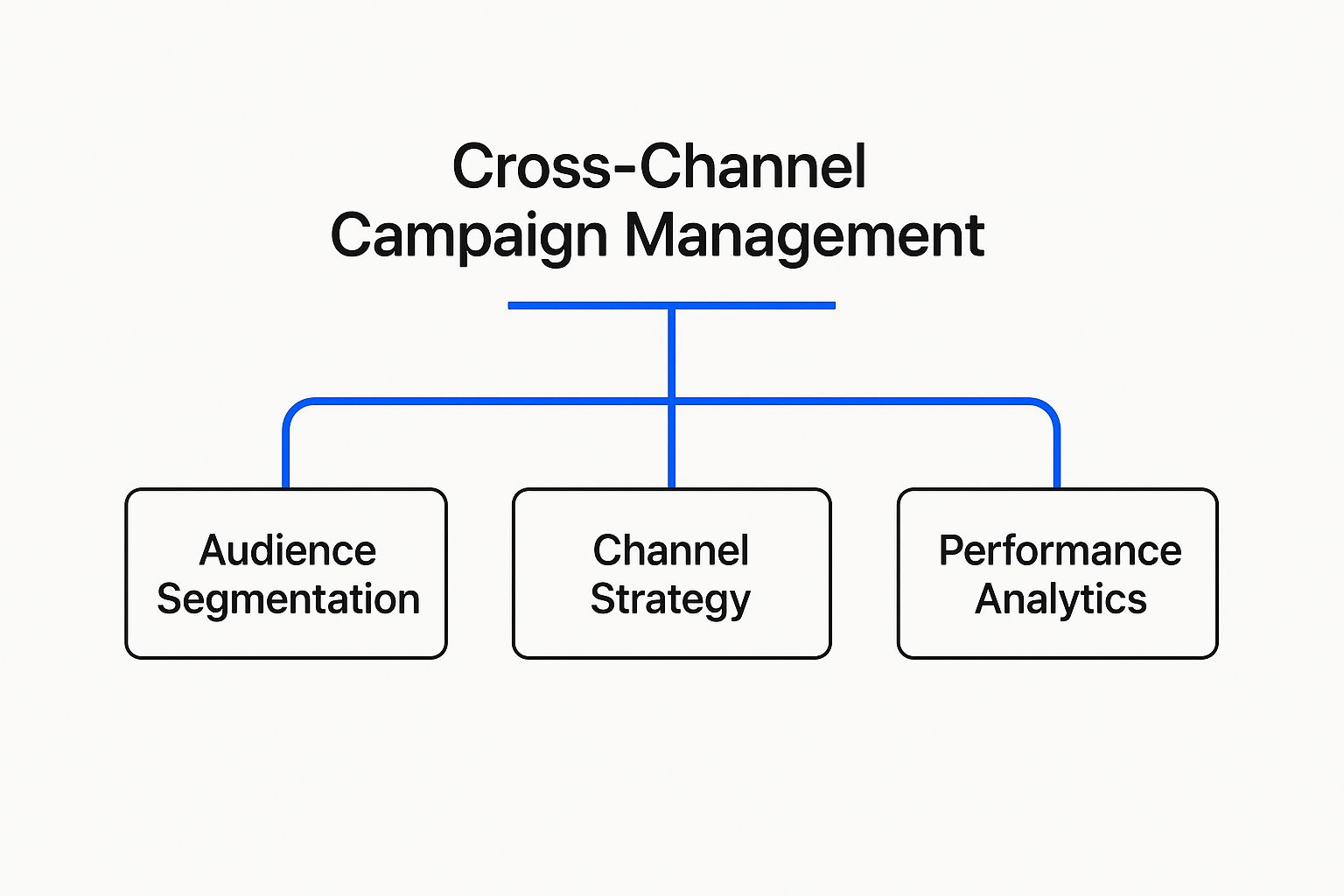Picture this: you're trying to piece together a conversation happening across phone calls, texts, and emails, but nobody remembers what was said last. It’s confusing, right? Cross channel campaign management is how you prevent that mess, creating one smooth conversation with your customers, no matter where they interact with your brand.
What Is Cross Channel Campaign Management?
Think of your marketing like an orchestra. In a typical setup, each instrument plays its own tune. That's multichannel marketing—your email, social media, and website teams are all active, but they aren't necessarily playing in harmony.
Cross channel campaign management is when a conductor steps in. The conductor ensures every instrument—every channel—plays together beautifully. It’s about creating a single, seamless experience where each touchpoint builds on the one before, turning separate marketing activities into one unified journey.
From Disconnected To Cohesive
Here’s how that looks in the real world. A customer sees an ad for a new pair of sneakers on Instagram. A few hours later, an email lands in their inbox showing different ways to style those exact sneakers. When they finally click over to your website, a banner at the top highlights a special offer for that same product.
See how that works? Each step feels like a natural, helpful continuation of the last.
This kind of coordinated approach isn’t just a nice-to-have anymore. A staggering 90% of consumers expect a consistent brand experience across every channel. And when brands deliver, they see real results.
It turns out that shoppers who engage with a brand through multiple channels spend 10% more online. Even better, campaigns using a cross channel strategy see 166% more customer engagement than single-channel efforts.
This handy infographic breaks down the essential pieces you need to build a winning cross-channel strategy.

As you can see, true success comes from weaving together audience segmentation, channel strategy, and performance analytics into one cohesive system.
Cross Channel vs Multichannel Marketing At a Glance
It's easy to mix these two terms up, but their core ideas are quite different. Multichannel is about being available on many channels, while cross channel is about being connected across them.
This table breaks down the key differences.
Ultimately, a multichannel approach gives your customers options, but a cross channel strategy connects those options into an intelligent, unified journey that just feels right. To get a better handle on the basics, it's worth exploring a guide to a modern multi-channel marketing strategy.
You can also get into the technical details of campaign tracking by checking out our guide on what a https://markopolo.ai/post/what-is-mark-html-tag is and how it works.
The Core Benefits of an Integrated Strategy
Alright, we've covered the 'what'. Now let's get into the 'why'—the real business impact of a unified strategy. Moving to effective cross-channel campaign management is like swapping a few disconnected snapshots of your customers for a full movie of their entire journey. With that complete picture, you get a much deeper understanding of who they are and what they need.
This deeper insight isn't just nice to have; it leads to real results. When you see the full context of how someone interacts with your brand, you can create experiences that feel relevant and timely. Instead of having separate conversations on each channel, you start weaving them into a single, supportive dialogue that builds trust and loyalty.

Unlocking a 360-Degree Customer View
The biggest win here is gaining a truly complete view of each customer. You can finally connect the dots and see how a social media ad leads to a later email click-through, or how an abandoned cart on your website can be saved with a perfectly timed push notification. This connected data lets you move beyond guesswork and start making decisions based on what people actually do.
Think about it this way: a customer who sees a social ad, clicks through, adds an item to their cart, and then leaves isn't just a lost sale. With an integrated strategy, that's your cue to send a gentle follow-up email showcasing the exact items they left behind, maybe with a small discount. You're turning a dead end into a second chance. This ability to manage the whole conversation seamlessly is what modern marketing is all about. You can explore how AI advertising is changing digital marketing in our detailed guide.
Driving Retention and Boosting ROI
This enhanced understanding has a massive impact on your bottom line. An integrated approach doesn't just improve individual metrics; it builds the lasting customer relationships that fuel sustainable growth. The data backs this up, showing that a cohesive strategy is a powerhouse for both retention and sales.
Brands that implement integrated cross-channel marketing strategies achieve an average customer retention rate of 89%. That's a huge leap from the 33% seen by companies with weak or siloed approaches.
It doesn't stop there. Customers who engage with brands across multiple channels tend to spend about 30% more than single-channel shoppers. On top of that, running a campaign across three or more channels can boost sales by around 14.6%. It’s clear proof that a well-executed cross-channel campaign management plan is one of the most effective ways to increase customer lifetime value.
Navigating the Common Sticking Points
While the benefits are huge, getting cross-channel campaign management right isn't a walk in the park. It comes with its own hurdles. Making everything work together smoothly is rarely easy. Many businesses wrestle with tangled data, tech that doesn't communicate, and teams stuck in their own little worlds.
These roadblocks are frustrating, but they’re not deal-breakers. The trick is to see them for what they are and build a plan to turn these challenges into a stronger marketing machine. By tackling these issues head-on, you can build the seamless experience your customers expect.
Breaking Down Data Silos
One of the biggest headaches is the classic problem of data silos. Your customer data is probably scattered everywhere—your CRM has one piece, your email tool another, and your social media analytics yet another. Without a way to connect these dots, getting a complete view of a customer is nearly impossible.
This fragmentation leaves you with blind spots. You might not realize the person who just opened your email is the same one who abandoned a shopping cart last week. A Customer Data Platform (CDP) is built to fix this exact mess. It pulls all that scattered information into one central hub.
Think of a CDP as a universal translator for your marketing tools. It gets everything speaking the same language so every team is working from the same complete customer profile.
This unified view is essential. The modern customer journey is a winding road, with people bouncing between channels. In fact, only 8% of consumers complete a purchase using just one channel. Despite this, a shocking 72% of senior marketers say that siloed campaigns are the number one thing holding back their ad spend efficiency. You can dig into more of these insights on what CMOs need to know about cross-channel advertising from CMORoom.com.
Fostering a Collaborative Culture
But technology can't fix people problems. Another major challenge is getting your teams to work toward the same goal. Your social media team might be chasing engagement, your email team is focused on open rates, and your content team is all about page views. When everyone has their own scorecard, the customer experience feels disconnected.
The only way around this is to build a culture of collaboration. Here are a few practical steps to get started:
- Set Shared Goals: Get everyone focused on big-picture business objectives, like customer lifetime value or overall conversion rates, instead of siloed, channel-specific metrics.
- Hold Regular Cross-Team Meetings: Get people in the same room (virtual or otherwise) consistently to share insights, sync up campaign schedules, and talk honestly about what’s working and what isn’t.
- Create a Centralized Content Calendar: A shared calendar is a game-changer. It lets everyone see all marketing activities in one place, making sure messages stay consistent and campaigns don’t trip over each other.
When you encourage open communication and shared ownership, you start to break down those internal walls. Suddenly, everyone is focused on telling a cohesive brand story that resonates with customers, no matter where they are.
A Practical Blueprint for Campaign Success
Ready to put this theory into practice? Pulling off a successful cross-channel campaign isn't as complicated as it sounds. The trick is to break the process down into clear, manageable steps. This creates a playbook that delivers a seamless experience for your customers and real results for your business.

This whole blueprint boils down to being intentional. It starts with a solid strategy built on good data, a real understanding of your audience, and a commitment to consistency. To keep things organized, using some solid marketing campaign planning templates can help you streamline everything and make sure no detail gets missed.
Build a Single View of Your Customer
Every great cross-channel strategy is built on a foundation of data. Your first move should be to break down those internal silos and bring all your customer information into one central place. Think about pulling data from your CRM, email platform, and analytics tools to create a single customer view.
This unified profile lets you truly understand how people interact with your brand across every touchpoint. It’s the difference between seeing a random email subscriber versus knowing that same person also follows you on Instagram and just spent ten minutes browsing three specific products on your website.
Map the Entire Customer Journey
Once you have that unified view, you can start mapping out the entire customer journey. This isn’t just a buzzword; it’s about visualizing every possible interaction a customer has with your brand, from the first time they hear about you all the way to their purchase and beyond.
When you identify the most critical touchpoints, you can strategically place the right message on the right channel at exactly the right time. For instance, your journey map might show that customers often research products on your mobile app but then switch to their desktop to make the final purchase. That insight is pure gold for optimizing both experiences.
A well-mapped journey ensures your messaging feels helpful and relevant, not intrusive. You're guiding the customer along their path, not just shouting messages into the void.
Personalize Content While Maintaining Consistency
With a clear journey map, you can start tailoring your content for each channel. The art here is striking the perfect balance between personalization and brand consistency. Sure, your tone on TikTok might be more playful than a formal email, but your core brand voice and values have to shine through everywhere.
Let’s look at a practical example:
- Scenario: A travel company is promoting a new vacation package to Hawaii.
- Website Browsing: A user checks out the Hawaii package page but leaves without booking.
- Email Follow-Up: The next day, an email lands in their inbox with the subject, "Your Hawaiian Getaway Awaits," featuring images of the exact destination they viewed.
- Social Media Ad: Later that week, a retargeting ad pops up in their social feed showcasing a limited-time deal for that specific Hawaii package.
See how that works? Each interaction is personalized based on their behavior, but the branding, visuals, and core message stay consistent. This cohesive approach builds trust and keeps your brand top of mind, gently nudging the customer toward a decision without feeling pushy.
Measuring Performance Across Channels
So, how do you know if your cross channel campaign is working? If you're still relying on siloed metrics like email open rates or social media likes, you’re only seeing a tiny piece of the puzzle. To really understand what's going on, you need to shift your focus to metrics that show the real impact on your business.
This is all about moving past vanity metrics and getting down to the key performance indicators (KPIs) that genuinely drive growth. The goal isn't just to see what happens on one platform; it's to connect a customer's action on social media to a final purchase on your website.
Moving From Siloed to Integrated Metrics
A truly integrated strategy demands a new way of looking at success. It’s about connecting the dots across the entire customer journey to see what's actually influencing behavior and driving sales. This becomes clear when you dig into the results of paid advertising with Google Ads, where it’s common for a customer to interact with your brand multiple times before converting.
Let's look at how the old way of measuring stacks up against a modern, cross channel approach.
Siloed vs. Integrated Campaign Metrics
The table below breaks down the move from channel-specific snapshots to a complete picture of customer behavior and value.
This shift is crucial. You're moving from asking "How did this email perform?" to "How did this email, this ad, and this blog post work together to create a customer?"
Adopting Holistic Performance Indicators
To get a true feel for how your campaign is doing, you have to adopt metrics that reflect the entire customer journey. This is the only way to get an accurate view of how each channel contributes to the final sale.
The core challenge in cross-channel campaign management is understanding the impact of each channel on a customer's buying decision. Advanced multi-touch attribution models were created for this reason, providing a fairer distribution of credit to each touchpoint.
Here are the essential metrics you need to start tracking:
- Customer Lifetime Value (CLV): This KPI measures the total revenue you can expect from a single customer over your entire relationship. It tells you if you're attracting high-value customers who stick around, not just one-time buyers.
- Multi-Touch Attribution (MTA): Instead of giving 100% of the credit to the final click before a sale, MTA models spread that credit across all the different touchpoints that influenced the conversion. This shows you which channels are your heavy hitters at different stages of the journey.
- Overall Journey Conversion Rate: Forget just looking at the conversion rate on your landing page. This metric measures the percentage of users who complete a goal across their entire journey, giving you a much more honest view of your campaign’s success.
Essential Tools for Your Marketing Tech Stack
Pulling off a sophisticated cross-channel campaign isn't about manual effort; it's about having the right tech in your corner. A well-built marketing tech stack is like the central nervous system for your campaigns, making sure every channel works in harmony to create one seamless customer experience.
Without the right tools, you're trying to conduct an orchestra while blindfolded. Data gets trapped, your messaging becomes a mess, and figuring out what’s working is a shot in the dark. The right technology cuts through that complexity, giving you the power to deliver personalized experiences efficiently and at scale.
Core Components of a Modern Tech Stack
To build a solid foundation, you need to focus on tools that nail three critical areas. These platforms don't work in isolation; they feed into each other to give you a complete picture of your customer and the ability to act on what you see.
- Customer Data Platforms (CDPs): This is your single source of truth. A CDP’s job is to pull in customer data from every touchpoint—your website, social media, CRM, you name it—and stitch it all together into one comprehensive profile for each person. This is the starting point for any meaningful audience segmentation.
- Automated Outreach Software: Once you know who you're talking to, automation tools let you orchestrate their journey. They’re the workhorses that handle tasks like sending a perfectly timed email after a customer abandons their cart or scheduling social media posts. It's all about timely, relevant communication without manual effort.
- Integrated Analytics Dashboards: These tools bring your performance data to life. Instead of just looking at siloed metrics, they help you visualize the entire customer journey, showing you which touchpoints are actually driving conversions and helping you hit your bigger business goals.

A dashboard like this gives you a unified, real-time view of campaign performance, letting you quickly see what's working and make decisions based on solid data. This kind of centralized hub is key for effective cross-channel campaign management, turning mountains of complex data into simple, actionable insights.
Frequently Asked Questions
Even with a solid plan, a few questions about cross channel campaign management are bound to come up. Let's tackle some of the most common ones.
What Is the First Step in Creating a Cross Channel Campaign?
Before you do anything else, unify your customer data. You can’t create a smooth journey for someone if you don't have a complete picture of them.
This means knocking down the walls between your data silos. Pull information from your CRM, email platform, and website analytics into one central place, like a Customer Data Platform (CDP). This gives you that single, complete view of each customer.
How Is Cross Channel Different from Omnichannel?
They sound similar, but there’s a key difference. Cross channel marketing is about connecting a few specific channels to create a unified campaign. Omnichannel marketing, on the other hand, aims for a completely seamless experience across every possible touchpoint—online, offline, in-store, and more.
Think of it this way: cross channel connects the dots for a specific campaign, while omnichannel aims to make the entire brand universe feel like one continuous conversation.
Can a Small Business Implement a Cross Channel Strategy?
Absolutely. You don't need a massive budget to get started.
The key is to start small. Pick two or three channels where your audience spends the most time, like email and Facebook. The goal is simply to make the experience consistent and connected between them. This is completely doable with the right marketing automation tools and a clear plan.
What Is the Biggest Challenge in Cross Channel Management?
The single biggest headache is data fragmentation. It’s a classic problem.
When your customer information is scattered across different tools that don’t talk to each other, you’re flying blind. You can't see the full customer journey, which makes creating a connected experience nearly impossible. Fixing this by centralizing your data is the foundation of any good cross channel strategy.
Ready to unify your data and put your campaigns on autopilot? Markopolo uses AI to bring all your marketing efforts together, giving you the clarity and tools you need for a truly seamless customer experience. See how it works at https://www.markopolo.ai.







.jpg)
.png)
.jpg)



